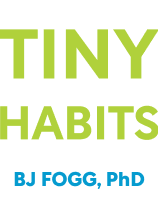

This article is an excerpt from the Shortform book guide to "Tiny Habits" by BJ Fogg. Shortform has the world's best summaries and analyses of books you should be reading.
Like this article? Sign up for a free trial here .
Looking to incorporate the Tiny Habits Method into your life? Do you want book exercises to help you practice?
In this article, we have put together an extensive list of Tiny Habits book exercises. These exercises will help you understand the concepts of the book better and start creating Tiny Habits in your life.
Continue on for Tiny Habits book exercises.
Tiny Habits Book Exercises
In Tiny Habits, Stanford behavioral scientist BJ Fogg argues that the best way to change behavior is to start small. Based on years of experience running a Stanford lab and helping people make changes through monthly Behavior Design Boot Camps, Fogg encourages us to drop any moral judgment about “good” and “bad” habits and view our behavior scientifically, using specific behavior design skills to engineer lasting changes. Through Tiny Habits, Fogg argues that the tiniest changes in our behavior can ripple out and have far-reaching effects, both in our own lives and in the lives of others.
Below are Tiny Habits book exercises to help you incorporate Fogg’s lessons into your life.
Choose a Habit to Work On
Think about an area of your life that might benefit from the Tiny Habits approach.
- What’s the habit that you’d most like to cultivate in your life right now? How can you create a Tiny Habit recipe for this behavior?
Recipe:
- After… [Anchor]
- I will… [Tiny Behavior]
- To celebrate, I will … [Celebration]
Try the Maui Habit
Experiment with the Maui Habit, a great way to start or continue the day on a positive note.
- At this moment, how are you feeling? List any emotions or thoughts that come up.
- Close your eyes and say, “It’s going to be a great day,” feeling genuinely confident and optimistic as you say it.
- How do you feel now? What’s changed?
- How might you integrate this habit into your daily life? List some possible Anchors for the habit. (For example: When my feet touch the ground in the morning; when I look in the mirror; the first time I walk into my office every day.)
Rethink Motivation
Dethrone motivation as the go-to solution for behavior change.
- What habit have you tried to create (or break) in the past by relying too much on willpower or motivation?
- Why was relying on motivation a problem in this case? (Did your motivation ebb and flow? Did you have conflicting motivations? Were your goals too abstract to be motivating?)
- Given the information in this chapter, what other approaches might you try? (For example, could you make the activity easier? Could you change the prompt?)
Map a Behavior on the Action Line
Learn to work with Motivation, Ability, and the Action Line.
- On a piece of paper, draw a vertical axis for Motivation and a horizontal axis for Ability. Now draw in the Action line curve.
- Think of one new habit you’d like to create and one unhelpful habit you’d like to break. Plot both behaviors. Where does each sit in relation to the Action Line? Are they close to the Action Line (easier to change) or far away?
- Take the new habit you’d like to create. List some ways you could manipulate ability to lift this above the Action Line.
Pilot the Selection Phase
Sketch out Steps 1 – 3 of the Behavior Design Process for a habit that’s meaningful to you.
Step 1. Pinpoint your exact aspiration or outcome.
- Generally speaking, what would you like to achieve? Is it an aspiration (an abstract idea) or an outcome (a concrete result)?
- Is this aspiration or outcome really targeting the underlying problem? Will implementing good habits in this domain have a direct effect on the problem? If not, come up with a new aspiration that better describes what you want to achieve.
Step 2. Brainstorm possible behavioral solutions.
Now you’ll create a diverse lineup of behaviors (“Swarm of Bs”) that might help you to achieve your aspiration and outcome.
If it’ll help you to focus, you could set a timer for two or three minutes. Include:
- One-off behaviors (deleting a social media app from your phone; buying a set of high-quality kitchen knives for food prep)
- Fresh habits to cultivate
- Unhelpful habits to drop
Step 3. Identify the Golden Behaviors.
In this step, Focus Map to find your ideal behavioral targets for change.
Write your Swarm of Bs on index cards, Post-it notes, or small pieces of paper. Sketch the axes below on a large piece of paper. (You could also do this digitally, using a tool such as Google Jamboard that allows you to move around digital Post-its.)
- Step 1: Impact. Arrange your behaviors along the vertical axis by looking at each and asking the question: Will this behavior help me to achieve my aspiration or outcome?
- Step 2: Feasibility. Consider each behavior individually, asking the question: Can I realistically get myself to do this behavior? Move each behavior to the left or right on the horizontal axis according to the answer.
- Which behaviors have ended up in the top right corner? Do they feel inviting and achievable?
Work With the Ability Chain
Identify strong and weak links in the Ability Chain.
- The “Ability Chain” has five links: time, money, physical effort, mental effort, and compatibility with daily routine. Think of a specific habit that you’d like to implement, or that you’ve been trying to implement without success. Assess each link in the chain individually. Which is the strongest? Which is the weakest?
- Any chain is only as strong as its weakest link. How could you strengthen the link that you’ve identified as being weakest?
Use Starter Steps and Scale Back
Practice creating your own Tiny Habit.
- There are two types of Tiny Habits that you can implement: “starter step” and “scaling back.” A stater step is when you isolate the very beginning of the behavior. (For example, if you want to start drinking a big glass of hot water with lemon every morning, a starter step might be putting the kettle on to boil.)
- Pick one or more new habits you’d like to introduce and list a few possible starter steps.
- A scaled-back version is a smaller version of the whole behavior. A scaled-back version might be making the lemon water and taking one sip.) For the same habit(s) you considered above, list a few possible scaled-back versions.
Create a Pearl Habit
- How might you turn an annoyance into a cue for positive change? In Pearl Habits, you transform events that usually prompt you to react negatively into prompts for a positive habit. (For example, Fogg turned the noise of an air conditioner into a prompt to relax.)
- Think of a few stimuli that usually annoy you or trigger a negative reaction.
- Which stimuli have the potential to become a Pearl Habit? What positive behavior could you use them to prompt?
Personalize Your Celebrations
Get to know your celebration style.
- What’s your personal celebration style? Do you like goofy, all-out celebrations, or are you more reserved and serious?
- There are a few different ways to celebrate: physical movements, words, songs, sound effects, and visualizations. Which of these categories appeals to you most? Why?
- Which specific celebrations feel like they’ll give you a feeling of Shine? (If it helps, think of what you naturally do in situations where you feel successful.)
- Can you think of a special Power Celebration for when you need to establish a new habit quickly? (Fogg’s is imagining his fourth-grade teacher putting her hand on his shoulder and saying “Good job!”)
Try a Celebration Blitz
Put celebration into action.
- Choose the messiest corner of your house or office. Set a timer for three minutes and start tidying things away. For every single thing you put away, celebrate! (You can use the celebrations you identified above, or whatever else feels right in the moment and gives you a sincere feeling of Shine). When the timer goes off, stop tidying and come back.
- What did you experience? Did you encounter any resistance? How do you feel now?
Work With Behavior Change Skill Sets
Identify your strengths and weaknesses in behavior change.
- Fogg identifies five different high-level skill sets for behavioral change: Strategy, Clarity, Process, Environment, and Attitude. Which of these is your strongest skill set? Which is your weakest?
- How might you strengthen your weakest skill set?
Design Away an Unwanted Habit
Select, analyze, and design away one of your Downhill Habits.
- Downhill Habits don’t require much effort to maintain, but it takes some effort to stop them. Identify one to three Downhill Habits in your current routine.
- Think of one of your worst habit tangles. What’s the broadest possible description for this tangle? (for example, eating unhealthy food, too much screen time, grumpy with family members.)
- Set a timer for two minutes. Think of the problem you wrote above and all of the specific behaviors that make it up. Write down as many of these specific behaviors as you can. (For example, snapping at your teenage son when he leaves clothes on the floor, giving your partner the cold shoulder when she doesn’t take out the garbage.)
- Consider everything you wrote above. Of all of these behaviors, which would be the easiest to change?
- How might you change the Ability and Prompt components of this behavior to make it harder?
Are You a Ringleader or Ninja?
Think about your behavior change leadership style.
- Ringleaders lead change overtly, often as group leaders or teachers, while Ninjas take a more stealthy approach. Which one of these approaches do you gravitate to more naturally?
- Now imagine you’re in the position that is less natural for you. (If you wrote Ringleader above, imagine you’re a Ninja. If you wrote Ninja, imagine you’re a Ringleader.) Of the seven steps of group change, which in particular might be challenging for you in this role? How might you address these challenges?
- (Reminder: The seven steps are 1) Pinpoint the aspiration or outcome, 2) Brainstorm possible behavioral solutions, 3) Identify the Golden Behaviors, 4) Find the tiny version, 5) Choose the prompt, 6) Celebrate, and 7) Repeat, refine, and upgrade.)
Identify Your Feedback Power Zone
Explore domains of maximum feedback impact.
A Feedback Power Zone is the overlap of a domain that’s important to you and a domain that you feel insecure about. See if you can identify some of yours.
- List a few domains that are important to you.
- List a few domains in which you feel insecure about your performance.
- Identify some domains where there’s overlap. What’s the most meaningful positive thing someone could say to you about a behavior in this domain?
- Think of someone you love or are trying to help. Can you list some of their Feedback Power Zones? What kinds of feedback might you give for behaviors related to these Power Zones?

———End of Preview———
Like what you just read? Read the rest of the world's best book summary and analysis of BJ Fogg's "Tiny Habits" at Shortform .
Here's what you'll find in our full Tiny Habits summary :
- How you can successfully create new habits that stick
- Why you don't need motivation, just science
- Why even flossing one tooth should be considered a victory






